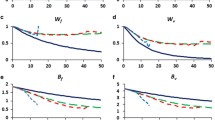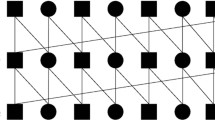Abstract
Supportive breeding is being increasingly usedas a measure to reduce the short-termprobability of extinction of populations withhighly reduced abundance relative to historicallevels. In this paper, we provide a conceptualframework and analytical tools to computechanges in inbreeding coefficient (F) in thecase of supportive breeding over any number ofgenerations. The dynamics of inbreedingcoefficients were investigated by means of asystem of recurrence equations. We focussed onquantifying the dynamics of F for specificcombinations of parameter values in terms ofthe effects of captive population census size,refreshment rate of breeders in captivity,scale of supplementation program, and migrationrate. We observed that supplementation did notalways result in substantial inbreedingincrement and several conditions loweredoverall inbreeding relative to controlsituations without supplementation. The censussize of captive populations was the single mostimportant controllable parameter determiningthe genetic consequences of supportivebreeding. While the proportion of captivebreeders brought into captivity from the wildbore a complex relationship to inbreedingcoefficient dynamics, the results indicatedthat managers should generally aim at highrefreshment rates (that is, large proportionsof their captive stock originating from thewild). This is especially important when asmall captive population is expected tocontribute large numbers of breeders to thesupplemented population. The analysis alsoshowed how supplemented populations connectedto a large metapopulation through gene flowrecover from the genetic risks of inbreedingdue to supportive breeding program more quicklythan isolated populations. The results of thisstudy join those of an increasing number ofinvestigations showing that supportive breedingdoes not always increase inbreeding, and mayeven decrease it in several circumstances.However, supportive breeding systems arecomplex, and results such as presented hereshould not be used in isolation, but inconsideration of other issues such as theconsequences on long-term fitness of wildindividuals.
Similar content being viewed by others
References
Caballero A (1994) Developments in the prediction of effective population size. Heredity, 73, 657–679.
Cuenco, ML (1994) A model of an Internally Supplemented Population. Trans. Am. Fish. Soc., 123, 277–288.
Crow JF., Kimura M (1970) An Introduction to Population Genetics Theory. Burgess, Minneapolis.
Crow JF, Denniston C (1988) Inbreeding and variance effective population numbers. Evolution, 42, 482–495.
Denniston C (1978) Small population size and genetic diversity. In: Endangered Birds: Management Techniques for Preserving Endangered Species (ed. Temple SA), pp. 281–302. University of Wisconsin Press, Madison.
Gharrett AJ, Smoker WW, Reisenbichler RR, Taylor SG (1999) Outbreeding depression in hybrids between odd-and evenbroodyear pink salmon. Aquaculture, 173, 117–129.
Hartl DL, Clark AG (1997) Principles of Population Genetics, 3rd edition. Sinauer Associates, Sunderland, Massachusetts.
Hedrick PW, Hedgecock D (1994) Effective population size in winter-run chinook salmon. Cons. Biol., 8, 890–892.
Hedrick P, Hedgecock D, Hamelberg S, Croci S (2000) The impact of supplementation in winter-run chinook salmon on effective population size. J. Hered., 91, 112–116.
Lynch M, O'Hely M (2001) Captive breeding and the genetic fitness of natural populations. Cons. Gen. (in press).
Marshall T, Spalton J (2000) Simultaneous inbreeding and outbreeding depression in reintroduced Arabian oryx. An. Con., 3, 241–248.
Monagan MB, Geddes KO, Heal KM, Labahn G, Vorkoetter SM, McCarron J (2000) Maple 6 Programming Guide. Waterloo Maple, Inc., Waterloo, Canada.
Ryman N (1994) Supportive breeding and effective population size: differences between inbreeding and variance effective numbers. Cons. Biol., 8, 888–890.
Ryman N, Laikre L (1991) Effects of supportive breeding on the genetically effective population size. Cons. Biol., 5, 325–329.
Ryman N, Jorde PE, Laikre L (1995) Supportive breeding and variance effective population size. Cons. Biol., 9, 1619–1628.
Ryman N, Jorde PE, Laikre L (1999) Supportive breeding and inbreeding effective number: reply to Nomura. Cons. Biol., 13, 673–676.
Utter, F (1998) Genetic problems of hatchery-reared progeny released into the wild, and how to deal with them. Bull. Mar. Sc., 62, 623–640.
Wang, J, Ryman N (2001) Genetic effects of multiple generations of supportive breeding. Cons. Biol. (in press).
Waples, RS (1999) Dispelling some myths about hatcheries. Fisheries, 24, 12–21.
Waples RS, Do C (1994) Genetic risk associated with supplementation of Pacific salmonids: captive broodstock programs. Can. J. Fish. Aquat Sc., 51 (Suppl. 1), 310–329.
Wang J, Caballero A (1999) Developments in predicting the effective size of subdivided populations. Heredity, 82, 212–226.
Wright, S (1931) Evolution in Mendelian populations. Genetics, 16, 97–159.
Author information
Authors and Affiliations
Corresponding author
Rights and permissions
About this article
Cite this article
Duchesne, P., Bernatchez, L. An analytical investigation of the dynamics of inbreeding in multi-generation supportive breeding. Conservation Genetics 3, 45–58 (2002). https://doi.org/10.1023/A:1014255005544
Issue Date:
DOI: https://doi.org/10.1023/A:1014255005544




